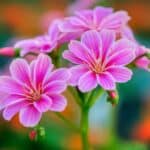Interested in learning more about the amaranth flower’s meaning? You’re in the right place.
The amaranth flower is a flowering plant that has been used for centuries as an important food and medicine. Amaranth in the Bible can be traced back to Biblical times when it was considered holy, and Jesus Christ himself may have eaten this cereal grain. The word amaranth means “everlasting.”
What Does Amaranth Mean?
Understanding the amaranth flower meaning starts with understanding its etymological meaning, which is “unfading.”
Amaranth (scientifically known as Amaranthus) is a genus of annual and perennial plants in the Amaranthaceae family.
The amaranth plant can grow up to 3 feet tall with flowers that come in shades ranging from purple, pink, red, white, and yellow.
Amaranth is a popular grain that has been used for millennia. It’s also one of the world’s oldest cultivated crops and was widely eaten in Central America, ancient Greece, Rome, Egypt, and China.
Amaranthus is a genus in the family Amaranthaceae, which includes about 200 species of herbs and shrubs. The name “amaranth” comes from Greek ἀμάραντος (“unfading”), because amaranth plants live for more than two years and do not lose their leaves seasonally.
What Do Amaranth Flowers Symbolize?
One of the most common amaranth flower meanings is that they are often said to represent immortality and life everlasting.
However, there are other meanings behind amaranth flowers as well.
Amaranth flowers are a beautiful addition to any garden. They have been used for centuries as an ornamental plant and food crop but they also have many different meanings associated with them.
Amaranth flowers are also seen as a amaranthus of the sun and light. Amaranth plants usually grow in sunny, warm climates and have been used by ancient cultures for centuries to signify rebirth, immortality, and purity.
The amaranth flower can even be associated with the Virgin Mary because her name means “wonderful” or “strong.”
What Do Red Amaranthus Flowers Symbolize?
Red amaranth is often associated with love and passion. It is a romantic color that symbolizes deep emotions, desire, and admiration.
Red amaranth flowers are often used in festive celebrations, and are known to evoke warmth and energy. Red amaranth is perfect for lovers who want to express their love and passion to one another.
What is the White Amaranth Flower Meaning?
White is a color that symbolizes grace and purity. The white amaranth flower can be an expression of purity and innocence. It is often used in weddings to symbolize the pure and true love that the couple shares. It is also perfect for those who are seeking peace and tranquility as it evokes a sense of calmness.
What Does Purple Amaranth Mean?
Purple is a color that is often associated with royalty and luxury. This color can also be associated with mystery and the unknown. Purple amaranth is perfect for those who value their independence and individuality. It can also be a symbol of abundance and prosperity.
What is the Pink Amaranth Flower Meaning?
Pink is a color that is often associated with femininity, love, and happiness. The pink amaranth flower can evoke feelings of empathy, compassion, and understanding. It is perfect for those who are seeking comfort and support, as well as for those who want to show affection to their loved ones.
What Does the Yellow Amaranth Symbolize?
Yellow is a color that evokes happiness, optimism, and joy. It is often associated with the sun and summer, and can uplift and energize those who are feeling down. Yellow amaranth can also be a symbol of respect and friendship. It is perfect for those who want to express their gratitude and appreciation.
What is the Cultural Significance of an Amaranth Flower?
Amaranthus is a type of flowering plant that grows in many different colors. In the past, this flower has been associated with immortality and eternal life because it does not die when cut.
Amaranth Flower Symbolism in Ancient Greece
The amaranth flower was also given as an offering of a few flowers to the gods as well as used by Greeks for decoration on gravesites.
It has been used as one of the symbols for ancient Greece because it was among the many wildflowers found growing on Mount Parnassus. This flower is commonly known to symbolize immortality or eternal life. This symbolism can be seen on many sculptures, jewelry, pottery, and paintings from Ancient Greek times as it was a popular symbol during that period for beauty and power.
Also in Greek mythology, it was said to be one of the flowers that sprang up from the blood spilled from Adonis when he died.
Amaranth is believed to have originated in the Andes region of South America. It was once consumed by the Incas and Aztecs but eventually fell out of favor. In Europe, amaranth was thought to be poisonous because it contains nitrates that can cause methemoglobinemia or “blue baby syndrome.”
Medicinal Benefits of Amaranth Flowers
Amaranth flowers come in various forms, from the symbolic Sage plant, the exotic Tassel Flower, the vibrant Love Lies Bleeding, to the graceful Prince’s Feather. For ages, these beautiful flowers have been used for their nutritional qualities and medicinal benefits.
The first few interesting facts that are worth mentioning are the firm connection between the amaranth seeds and its flowers. In most cases, the amaranth seeds bring forth amaranth flowers in a range of colors, including green, purple, and red. The flowers are known to be rich in amino acids such as lysine, which is rare in other types of plants. This makes them a valuable food source, particularly in countries where malnutrition is prevalent.
Amaranth flowers are symbolically used for their medicinal properties and their ability to reduce cholesterol levels. The flowers contain a high level of fiber that works to decrease the amount of low-density lipoprotein (LDL) cholesterol in the body. Some studies have indicated that incorporating amaranth into your daily diet can lead to reduced levels of triglycerides, another type of unhealthy cholesterol.
In addition to reducing cholesterol levels, amaranth flowers have also been shown to be an excellent source of protein. They contain amino acids such as cysteine, methionine, and lysine, which are incredibly beneficial to the human body. Lysine-rich plants, in particular, are an unusual find; they are an essential part of a healthy and well-balanced diet. As a result, adding amaranth flowers to your meals can provide you with the nutrition perfectly suited for your body’s needs.
Another distinctive feature of amaranth flowers is their long-lasting nature. It is believed that their ornamental interest is due to their ability to bloom for many months. This means that you can have access to a fresh supply of amaranth flowers all year round. Plus, they are relatively easy to grow and maintain.
What is the Symbolism of an Amaranth Tattoo?
For some people, amaranth flowers symbolize strength and endurance. For others, a reminder they are not alone in this world.
The true meaning and symbolism of an amaranth flower tattoo can vary from person to person, as you can see. Thisf lower can symbolize good fortune, eternal love, the rite of Christian communion, or even unfading affection.
Amaranthus tattoos are often a symbol of immortality. The amaranth flower is the flower that never dies, and it’s also a popular figure in Greek mythology as well as other cultures around the world.
This symbolism, from Greek myths to everything else, is what makes amaranth tattoos so attractive to people who want to show their eternal youth or everlasting life.
When Should You Give Someone an Amaranthus Flower?
The amaranthus flower is a symbol of love and beauty. Its true meaning is hard to decipher, but it’s thought that this flower could represent eternal life or hope for peace. Giving someone an amaranth flower can be seen as a gesture of admiration, friendship, and love.
It has also become popular, in some parts of the world, for couples to give each other amaranth flowers on their wedding day as a sign that their love will last forever.
Check our blog for more flower meanings.
*image by orestligetka.ukr.net/depositphotos







